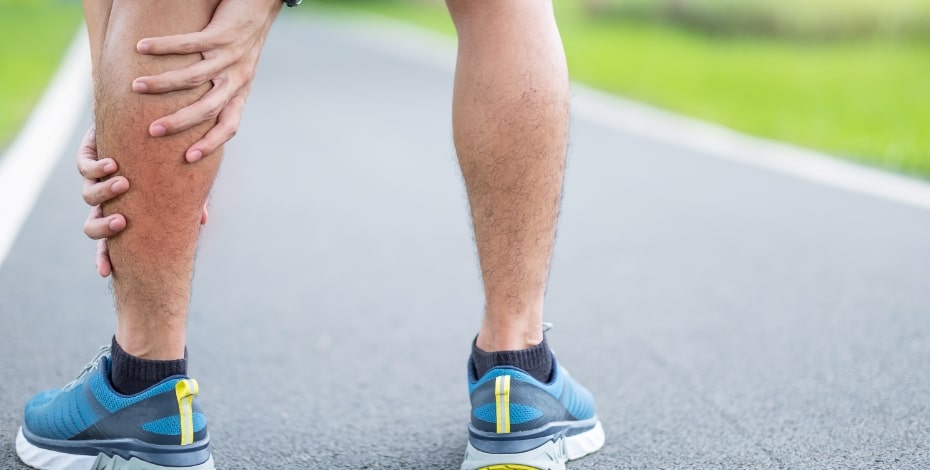
Understanding risk factors for calf muscle strains

In a study funded by the Physiotherapy Research Foundation with support from PRF corporate partner ASICS, Brady Green is aiming to better understand the factors predisposing football players to calf muscle strain injuries, with an eye to better management and prevention.
Calf muscle strain injuries (CMSI) are one of the more prevalent sports injuries, with a far- reaching impact on all kinds of athletes— from recreational sportspeople to elite professionals—across a wide spectrum of sports, codes and ages.
They are also associated with an elevated susceptibility to recurrence, which can extend the time away from sport from weeks into months.
Dr Brady Green, a senior lecturer in musculoskeletal physiotherapy at The University of Notre Dame Australia in Fremantle, has been working on CMSI and other muscle strain injuries for several years, focusing on assessment, management and prevention.
As a former member of the physiotherapy team at Essendon Football Club, Brady saw firsthand the impact of CMSI on athletes.
‘While I was completing my PhD [at La Trobe University], I was embedded in the industry, working at Essendon, and it was good to be able to get that practical understanding of the data,’ he says.
Brady says that while most CMSI are the result of classic mechanisms of injury, including steady-state running, acceleration, high-intensity running, jumping and landing, they can also occur without a clear inciting mechanism.
‘An athlete might have pulled up sore from a run, or a few days after a run they might have some residual calf tightness and soreness, and when you assess it, it’s apparent that it’s a strain injury,’ he says.
CMSI have become a burden for elite athletes in sports like Australian football, where players may end up unavailable for a significant portion of the season as a result of the injury.
‘We need to get to the bottom of the factors predisposing players to these injuries so that we can have the best chance at preventing them.
‘With consistent rates of injury and recurrence and potentially a growing injury burden, we’re keen to understand more about calf strains,’ Brady says.

Dr Brady Green is looking at the impact of calf muscle strain injuries in football players.
Brady was recently awarded a Physiotherapy Research Foundation Seeding Grant to try to identify risk factors for CMSI in Australian football players.
In particular, the study will focus on the impact of calf muscle strength, measured as the maximum isometric capacity, on the risk of subsequent CMSI.
‘We are asking if somebody’s baseline level of calf muscle strength is related to whether they have a subsequent calf strain or not,’ Brady says.
The study will focus on male and female football players at the elite and sub-elite/ semi-professional levels, says Brady, who is hoping to recruit more than 600 players in Western Australia and Victoria across the 2024 season.
Players in the study will be assessed during preseason training, giving the researchers a baseline of their calf muscle performance.
Injury data will be collected for each participant throughout the season, including the mechanism of injury, the type of CMSI (index or recurrent), the muscle injured and other injury characteristics.
Player demographics such as gender, height, weight, age, ethnicity and playing position will also be collected.
Potential risk factors will be identified through statistical analysis of the collected data.
Brady says that in the near term, the data may allow management teams to identify players who may be at risk of CMSI so that preventive measures such as strengthening and load management can be incorporated into their programs.
Ideally, he says, a follow-up study would look at whether repeating the assessments at regular points throughout the preseason and playing season could be used to prevent injuries from occurring.
‘We might be able to establish that if a player’s strength drops by, say, 15 or 20 per cent, it could be a high-risk situation in the short term.
‘Physiotherapists could then put into place some preventive strengthening, plyometrics and load management, tailored to the individual that they’re working with, over a longer period of time.’
Brady expects to have collected all the data required for the study by the end of the women’s playing season and will complete the statistical analysis next year, although he says preliminary data based on the men’s preseason/playing season may be available sooner.
In addition to widening the study protocol to include time points throughout the season, he hopes to complete similar studies in other athletic codes such as rugby, soccer, cricket and athletics.
‘In terms of causation, there are potentially different risk factors and causes for calf strains across athletic groups,’ he says.
‘That would be very useful clinical information for practitioners to have if they’re treating a football player compared to a marathon runner or a basketball player.’
© Copyright 2024 by Australian Physiotherapy Association. All rights reserved.





